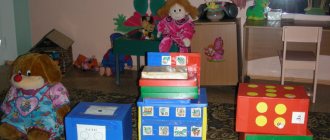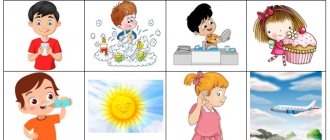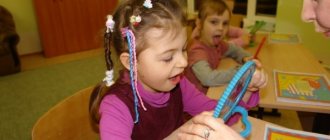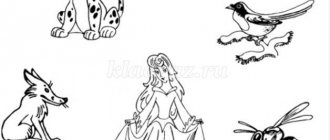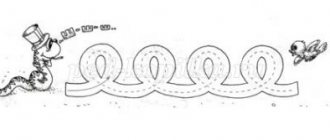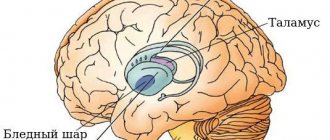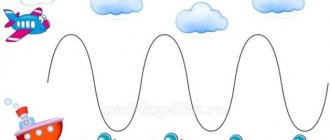Pathology options
The distorted pronunciation of L is called lambdacism. The cause of this disorder is the incorrect position of the articulation organs during sound pronunciation. In addition, there may be substitutions of one phoneme for another - paralambdacisms. Most often, the child chooses a sound with simpler articulation. Also, L may simply be absent in speech - the baby does not distort or replace it with another phoneme.
Types of lambdacisms:
- bilabial - in speech one hears Yu instead of L due to the fact that the tongue is not raised and the child pronounces the sound using the lips;
- nasal - during articulation, the tongue touches the soft palate, so part of the air stream passes through the nose, this adds a nasal sound;
- interdental - the tip of the tongue passes between the teeth.
Types of paralambdacisms:
- replacement with iotated vowels (Ё, E, Yu, I);
- on Vy.
Most often there are replacements from L to L, because the articulation of the latter is simpler. But sometimes there is a violation of the pronunciation of soft sounds. Properly selected exercises help correct this defect.
Etiology of disorders
Incorrect pronunciation can be a sign of either dyslalia (a simple speech disorder) or more serious speech disorders. The emergence of lambdacisms and paralambdacisms is due to the following reasons:
- violation of muscle tone of the tongue;
- immaturity of articulation organs;
- phonemic hearing impairment;
- incorrect speech environment in which the child grows up.
The speech therapist determines the cause during the diagnosis, which he conducts before the start of classes. And based on the results, the specialist selects a set of suitable corrective exercises.
Speech therapy diagnostics
Before starting to work with a preschooler, a speech therapist conducts diagnostics to determine the speech disorder and the mechanisms of the disorder. He checks the condition of the motor sphere. Particular attention is paid to the articulatory apparatus: its anatomical features and motor skills. The child is asked to perform static and dynamic exercises.
The specialist also checks the sound-pronunciation side of speech. Diagnostics includes checking:
- pronunciation of all phonemes;
- tempo-rhythmic component;
- syllable structure.
The speech therapist begins to check sounds with isolated pronunciation, then in syllables and words. The specialist also pays attention to how the baby pronounces phonemes in normal speech. Then the speech therapist looks at the formation of phonetic-phonemic processes. Checking this block includes:
- assessment of phonemic hearing (recognition and discrimination of sound in the speech stream);
- formation of sound-letter analysis;
- working with paronymous words.
The speech therapist necessarily checks the impressive and expressive vocabulary - speech understanding, vocabulary and how he uses it in his speech. Then the formation of grammatical structure and coherent speech.
The speech therapist selects speech material for diagnosis in accordance with the child’s age. Also, parents should not worry too much if a child at the age of 3 cannot pronounce the sound L. The sonorous group is formed closer to 4-5 years, but it is worth paying special attention to the rise of the tongue.
Timely speech therapy diagnostics will identify possible problems that may cause distortion of sound pronunciation. The speech therapist will select exercises that prepare the organs of articulation for pronouncing the sound L.
Exercises
Differentiation [l], [l] will be more productive if you approach classes as a game. L.A. Komarova developed an original method of individual and group work with preschool children with speech disorders. This method is based on games with cards and flat toys (walkers). Kindergarten children hold a pointer or a Kinder toy in their hands, use auxiliary elements to navigate through cards with pictures, and complete tasks from a teacher or parent.
Puzzles
Adults name the characteristics of objects (external, taste, any others), and the preschooler guesses its name. In this case, the child is presented with options for the correct answer in pictures. For example, the teacher says: “Yellow, sour, oval...” (lemon). The baby points to an object and names it.
What's missing
Exercise develops memory and attention. Place a large card with images of objects on the table (no more than 9 pieces, you can start with 3-4 pictures). The child looks at the card and remembers that it shows 1-2 minutes. Then the teacher covers 1 picture, and the child says what is missing from the field.
A set of articulation exercises
Before staging L, it is necessary to carry out a preparatory stage. It includes the preparation of the organs of articulation, the normalization of their muscle tone and the formation of the psychological basis of speech. In gymnastics for the organs of articulation, the main emphasis is on developing the elevation of the tongue.
- Basic exercise “Smile” . The preschooler is asked to smile and fix his lips in this position.
- They teach you to make your tongue narrow . The student smiles, makes his tongue narrow and tries to stretch it out as far as possible. This exercise is static.
- You also need to develop the ability to make your tongue broad . You need to smile, place your tongue on your lower lip, making it wide. This task is also static.
- The basic task for forming the rise of the tongue is “Swing” . The lips are in a smile, the narrow tongue needs to be raised and lowered.
- This list should include a basic exercise for hissing people - “Cup” . The mouth is open, the tongue is wide. It is raised so that it is shaped like a cup.
- To develop the ability to raise the back of the tongue, pronounce Y as long as possible , keeping your mouth open.
- Another task for developing tongue elevation is “Turkey” . The mouth needs to be opened slightly, a wide tongue is placed on the upper lip. Without lifting it from your lip, you need to perform forward and backward movements. First slowly, then speeding up the pace, add your voice. It should look like BL-BL (turkey popping).
- The most famous exercise is “Horse” . With the addition of vocal cords, the baby can then be encouraged to click silently.
When pronouncing L correctly, the air stream should pass through the side edges. With nasal lambdacism, you need to form the correct exhalation. The lips are fixed in a smile, the mouth is slightly open. Lightly bite the tip of your tongue with your front incisors and blow. The air stream should not pass through the center, but along the side edges.
To normalize the muscle tone of the organs of articulation, the speech therapist prescribes a special massage (for complex speech disorders) or the baby can do self-massage (patting and biting the tongue). The preparatory stage takes several lessons to form the desired articulatory pattern.
Speech therapist's notes - Differentiation of sounds L - L
Topic: “Differentiation of sounds L - L”
Goal: - teach, differentiate sounds by ear and pronunciation.
Tasks:
- improve the skills of sound-syllable analysis and synthesis;
- teach, listen carefully to the speech of an adult, correctly understand logical and grammatical structures;
- continue to learn how to make sentences with a given word;
- learn to isolate words with given sounds from the text;
- consolidate the ability to select related words;
- strengthening the skill of agreeing adjectives with nouns.
Equipment: handouts, pictures, game “Train”, “sun”.
Progress of the lesson
1. Ogre. moment.
Finger gymnastics “Swallow”.
Game "Answer questions".
Brother calls sister home. Who is home? (Brother). Lena listened to Misha. Who spoke? (Misha). Vanya walked ahead of Petya. Who was last? (Petya). Forest behind the house. What's ahead? (House). The bus is driving ahead of the truck. What's behind? (Truck) A cat is bigger than a dog. Who is smaller? (dog) The boy is taller than the girl. Who's lower? (Girl) Grandfather is older than grandmother. Who is younger? (Grandmother) Oak is taller than birch. What's below? (birch)
Train game
Determine the number of syllables in a word. In the first carriage there are pictures with one syllable in the title. In the second car there are pictures with two syllables in their titles. In the third car there are pictures with three syllables in the name. (stork, starling, heron, crane, lily, snowdrop, cornflower, oak, maple, spruce). For example: My picture will travel in the first carriage because the word spruce has one syllable. How can you call the “passengers” in the first carriage in one word? What is this? (trees). How can you call the “passengers” in the second carriage in one word? Who is this? (birds). What kind of birds are these? (passengers) How can you call the “passengers” in the third carriage in one word? What is this? (flowers). Young green leaves appear on the trees. Migratory birds arrive from warm countries. The first flowers are blooming. What time of year does this happen? (in spring) Remember and name related words to the word spring – spring, freckles, freckles,….
2. Introduction to the topic.
The sun appears without any rays. What is the third sound heard in the word - sun (L) Today let’s remember the sounds L and L. Remind the articulation of the sound L:
- lips in a slight smile;
- the teeth are visible and close together;
- the narrow tip of the tongue is raised by the upper teeth, pressed;
- the neck "works".
(pronounce)
What prevents the air stream from coming out of the mouth? (tongue, teeth) Characteristics of sound. (consonant, hard, voiced). (given by the child) The symbol is sound. Designation. Articulation of the sound L:
- lips in a slight smile;
- the teeth are visible and close together;
- the tip of the tongue is raised by the upper teeth, pressed against the tubercles;
- the neck "works".
(pronounce)
What prevents the air stream from coming out of the mouth? (tongue, teeth) Characteristics of sound (consonant, hard, voiced). Symbol sound. Designation.
3. Game "On the contrary"
| La - la Lo - le Lu - lyu Ly - li | al - al ol - ol ul - ul il - il | bow - hatch corner - coal yula - Yulya ate - spruce | jackdaw - pebble shelf - polka |
4. Game “Catch the Sound”.
(one team “catches” the sound l, the other - the sound l) La, la, lo, le, ate, slu, walked, walked, crowbar, ice, viburnum, wicket, ear, log, cold, stripe….
5. Game “Finish the word” (l or l)
One hundred..., st..., po..., ugo..., foam..., bo..., so..., mo..., ro....
6. Game "Guess"
lapi, ka-pol, lashko, dyshlan, lo-mo-tok, pa-lota, lakuk, kalozh, ka-bel, baklum, toch-laska, shad-ka-lo.
7. Complete the word and lay out a diagram of this word..
| Ding-dong, ding-dong (an elephant) walks in the alley |
| A red fox often goes to the lake to drink |
| Christmas tree, Christmas tree, Christmas tree – Spiky (needle) |
| Even if the roof is leaking and the gate is broken, the snail will never leave its house. |
Come up with a sentence with one of the words (snail, elephant, fox). How many words are there in a sentence? Is there an excuse?
8. Physical education minute.
(remember where is right and where is left) Touch your left ear with your right hand. Touch your left knee with your left hand. Jump on your right leg three times. Jump on your left leg twice.
Game “What Can You Say About” (white, white, white, green, green, green.)
9. Isolating sounds (L, L) from the story.
“The Fox and the Goslings” Lucy was herding geese and goslings in a clearing near the forest. A fox jumped out of the forest. She saw geese and goslings. The fox hid behind the bushes. The geese and goslings ate and lay down in the clearing to sleep. They didn't see the fox. The fox crept up and grabbed one of the goslings. The fox carried the gosling away to her hungry cubs.
Count how many sentences are in the story.(8)
10. The sun continues to smile, but what is the sun missing? (rays)
Come up with words with the sound l (long rays) and with the sound li (short rays).
11. Summary of the lesson.
What sounds did we compare? Describe the sound l (l). What did you like about the lesson?
Author of the material: Medvedkova Nadezhda Gennadievna
Also on topic:
Group lesson for children with phonemic speech underdevelopment
